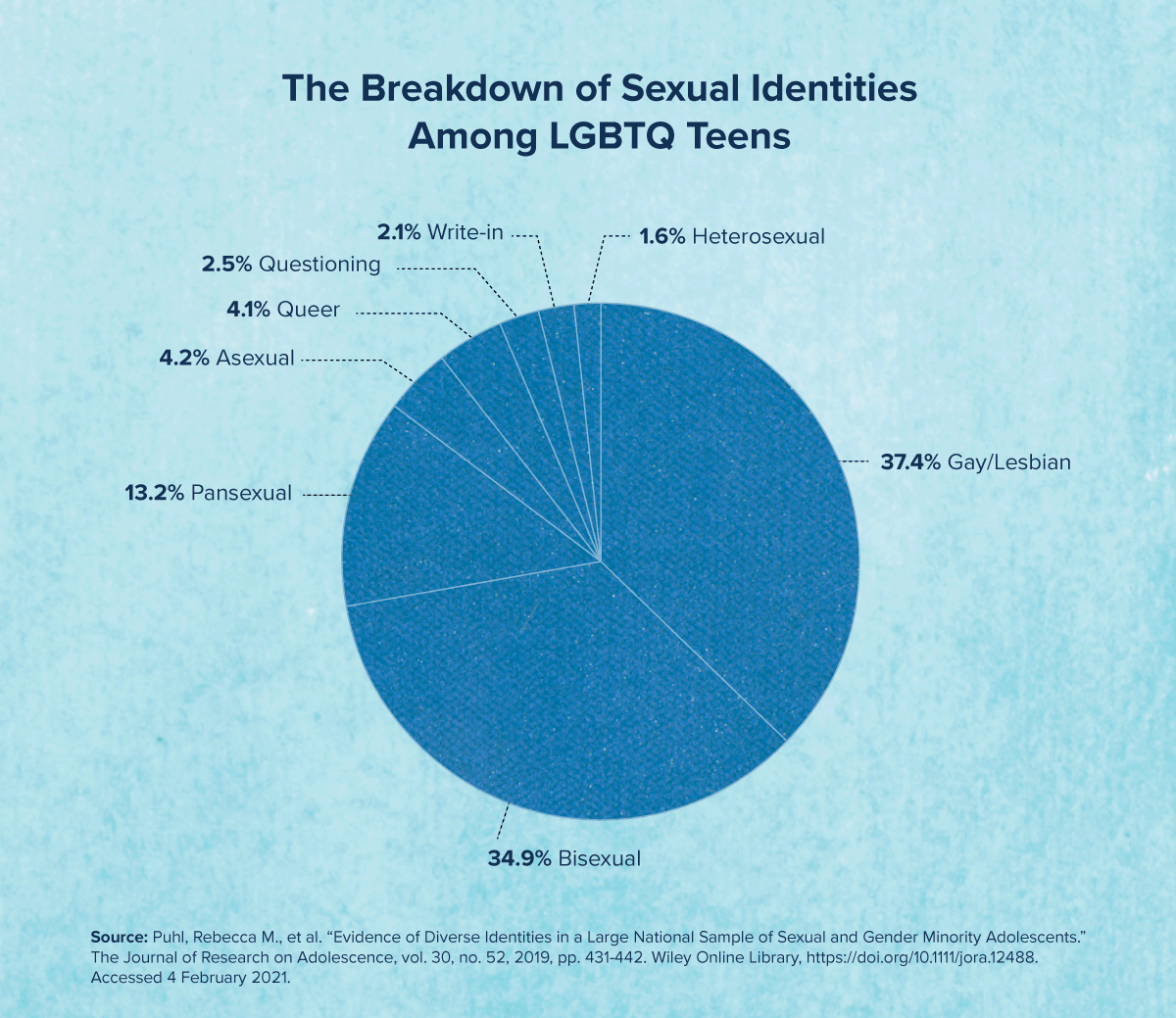How to Support Adolescents Questioning Their Sexuality

Being a teenager can be confusing. Not only is your body going through physical changes, but you’re also learning how to construct your own identity and navigating how you relate to the world. Sexuality is a big part of that personal journey. But knowing where you identify across the sexuality spectrum doesn’t always come easy.
“Questioning is a natural process,” said Dorothy Espelage, an educational psychologist and professor of education at the University of North Carolina. “Teens may find they’re attracted to both sexes or none at all, but you’ve got to remember that adolescence is a time where they don’t necessarily want to be put in a box because they don’t always see themselves represented in traditional categories of straight, gay, lesbian or bisexual.”
For some teens, questioning their sexual identity can feel like living in limbo. When confronted with the instinctive desire to belong somewhere, it can be stressful to figure out where they stand in society by themselves. Adults in their lives can help them navigate this experience by carving out a healthy space for them to explore their questions safely and by validating what they are going through.
How Many Teens Identify as Questioning?
According to PFLAG, teens who have not yet defined their sexual identity are considered questioning under the LGBTQ umbrella. The organization notes that the benefit of being able to identify yourself as questioning honors the need for self-exploration while providing a space within the community.
“I think for some teens it’s very distressing to think, ‘I don’t know where I fit.’ When they are given so few options of how to identify, they don’t feel as included,” Espelage said.
A 2019 study of teens’ diverse sexual identities (PDF, 193KB) found that many LGBTQ youth are identifying more with emerging sexual labels, including questioning, than traditional labels.

In 2019, roughly 2.5% of teens across different gender expressions identified as questioning.
Data: See frequences of LGBTQ demographics by gender identity (PDF, 189KB).
Navigating Challenges that Come with Questioning Your Identity
The experience of questioning sexuality is different for everyone, but can be influenced by the environment in which they live, family and friends they interact with, and the overall community they are a part of, Espelage said. An affirming and accepting community may respond differently than a more conservative community, but even within those communities, teens may find more accepting people to lean on.
“It’s just hard for some heteronormative families who fear that (because their child is) a gender or sexual minority today, life is going to be hard in some parts of our country,” she said. “The parents are well-intending, but there’s something risky about the unknown space of questioning.”
Friends can be a strong source of support for their questioning peers. But interacting with other teens who don’t share the same internal struggle can sometimes feel isolating for adolescents.
“There’s something about not knowing when people around you know,” Espelage said. “If you’re in a peer group where everyone is gender-fluid, questioning will likely look different because you aren’t the only one. But say if you’re one of the girls in a group of girlfriends who are all boy-crazy except for you, that’s where the angst can come from.”
While the U.S. has made important strides in acceptance and tolerance of LGBTQ individuals, anti-queer bullying is still commonplace among younger people. According to the Gay, Lesbian and Straight Education Network’s (GLSEN) 2020 National School Climate Survey (PDF, 5.1MB), which reports on LGBTQ youth in schools:
MORE THAN 8 IN 10
LGBTQ students experienced harassment at school.
OVER TWO-THIRDS
of LGBTQ students were verbally harassed due to their sexual orientation.
RELATIONAL AGGRESSION
(such as spreading rumors) was reported by most LGBTQ students.
OVER TWO-FIFTHS
of LGBTQ students experienced cyberbullying.
Espelage noted that questioning teens tend to have the highest rates of victimization by their peers. In her study on effects of bullying on LGB and questioning students in schools, Espelage concluded that “students who were questioning their sexual orientation reported the most bullying, homophobic victimization, drug use, feelings of depression and suicidality, and more truancy than straight or LGB students.”
Often, homophobic victimization comes from within a peer group, sometimes masquerading as jokes. While Espelage said homophobic namecalling can be pretty normative, it can be a source of added pressure for questioning teens.
“If you’re solidly gay and out, but someone calls you a homophobic slur, you’re like, ‘Yeah, so what?’ ” Espelage said. “But if you’re really struggling with your identity and have to deal with that on a daily basis from your trusted friends, that’s very hurtful. And to attack that you almost have to come out.”
These situations can leave teens feeling like they have to make a decision about how to identify, before they fully know themselves and are ready to share, Espelage said. She also noted that prematurely identifying could close them off from exploring their identity with LGBTQ-affirming groups or organizations, out of the fear that others will assume they are LGBT. At the same time, “coming out” could elicit strong reactions from people who make assumptions about who the teen is when they are still learning about themselves.

How to Support Questioning Teens
Affirmation, strong family and social support, and open communication can help teens navigate this period of questioning while staying mentally resilient, Espelage said.
Adults should reevaluate their own biases and assumptions about the LGBTQ community to begin to create more inclusive environments that allow teens to safely explore questions about their sexuality. Espelage offered the following suggestions for adults:
Think of sexuality as a spectrum.
It’s also a continuum, which means that sexual identity can evolve slowly over time.
- Be Yourself: Questions and answers for Lesbian, Gay, Bisexual, Transgender, Queer, and Questioning Youth, PLAG (PDF, 456KB): a list of frequently asked questions by teens about understanding their sexuality, determining when to come out, defining sexual identity terms, and learning about mental health and the LGBTQ community.
- Glossary of Terms, Human Rights Campaign: a glossary of LGBTQ terms and identities designed to help make conversations more open and comfortable.
- Research Brief: Diversity of Youth Sexual Orientation, the Trevor Project: based on data from the National Survey on LGBTQ Youth Mental health, this brief provides a snapshot of inclusive identities that teens identify with and distinguishes sexual and romantic attractions.
- Resources on Gender-Expansive Children and Youth, Human Rights Campaign: a list of resources dedicated to gender expansive youth who may identify as transgender or another identity not confined to one gender experience.
- The Family Acceptance Project: a research initiative dedicated to helping families and communities support LGBTQ youth in a culturally competent way.
- Mentoring Lesbian, Gay, Bisexual, Transgender, Questioning, Intersex, and Gender Non-conforming Youth, National Mentoring Resource Center (PDF, 692KB): a guide for adults about how to build relationships with and mentor LGBTQ youth, emphasizing the importance of role models and non-parent adults that can support the mental health and self-esteem of LGBTQ teens.
Remember that outness is not static.
People can be “out” in certain contexts and not others. They may be out at school and not at home or vice versa. Give teens agency over their coming out process while maintaining confidentiality. Espelege encouraged adults to:
- Avoid asking questions such as, “Are you gay?” It’s important not to push teens before they are ready. Give them space to figure it out at their own pace.
- Have conversations guiding teens on how to cope when they’re at different points of the coming out process. It’s important for teens to safely manage their identity through the various contexts they live in and experience.
- Be clear and affirming with support and encouragement that is unconditional.
- Actively listen to a teen when they are expressing themselves and don’t shut them down with phrases such as, “Well, you know you like boys,” which can invalidate their sexual and/or romantic feelings.
Encourage healthy exploration.
Emphasize that sexuality is a natural and normal process to learn about and it’s up to them when they choose to explore that, Espelege said. This can be best done in an inclusive environment.
- Schools can serve as a neutral buffer, especially if questioning teens come from non-affirming families. Gender-sexuality alliances provide a safe space for LGBTQ youth to have peer-to-peer conversation under faculty support. These organizations can provide a space where students can process difficult emotions, while also providing mentor figures, such as a junior or senior classmate who has been in their shoes and can offer advice and guidance.
- What is a GSA Club, GSA Network: an introduction guide to GSAs, what they are, and how to start one.
- Support for Student-Led Clubs, GLSEN: a resource dedicated to supporting GSAs for students and advisers.
Promote tolerance.
Teens are watching adults closely to determine if they will be supportive. It’s important for adults to advocate for LGBTQ tolerance and acceptance.
- TV Shows with LGBTQ+ characters, Common Sense Media: a list of TV shows with LGBTQ-inclusive character portrayals that are child and teen appropriate. It’s important to see diversity in sexual identities represented in media, but how they are portrayed is significant (i.e., if the show is not expliclty pointing out that a gay couple, but they are a natural and accepted part of it without question).
- Supporting LGBTQ Students During Social Distancing, the Trevor Project: a guide to helping LGBTQ youth cope with the social isolation of the pandemic, especially if they are having a hard time finding an accepting community at school without the physical environment or may not find acceptance at home with their family.
- Safe@School: a list of lesson plans and toolkits for educators and other adults to promote and teach tolerance to students.
- Lifeguard Workshop, the Trevor Project: a video for educators, counselors, or youth service leaders to help LGBTQ young people identify potential challenges and manage their mental health.
The following section contains tabular data from the graphic in the post.
The Breakdown of Sexual Identities Among LGBTQ Teens
| Sexual Identity | Percentage of LGBTQ Teens |
|---|---|
Gay/Lesbian | 37.4 |
Bisexual | 34.9 |
Heterosexual | 1.6 |
Pansexual | 13.2 |
Queer | 4.1 |
Asexual | 4.2 |
Questioning | 2.5 |
Write-in | 2.1 |
This article was updated February 2021.

